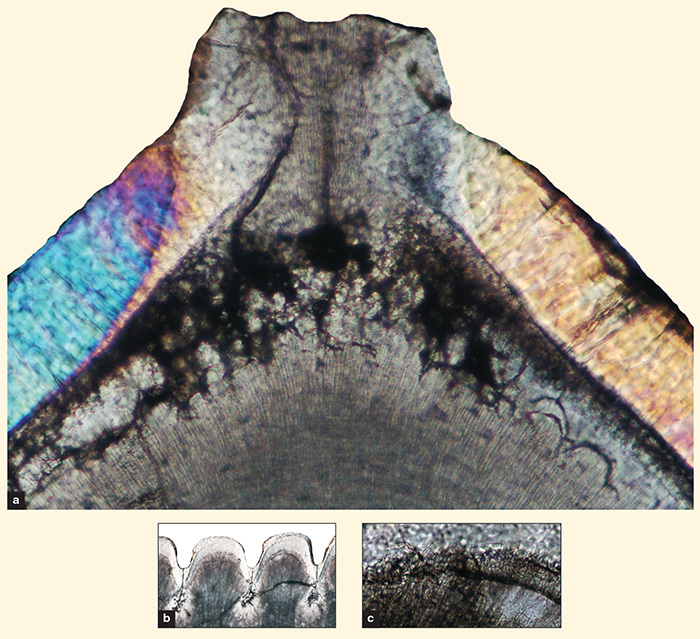A Story of Serration
By Sandra J. Ackerman
How did theropods, the meat-eating dinosaurs, develop their distinctive serrated teeth? High-tech microscopy reveals new clues.
How did theropods, the meat-eating dinosaurs, develop their distinctive serrated teeth? High-tech microscopy reveals new clues.

DOI: 10.1511/2015.117.379
The predatory dinosaurs of the Mesozoic Era had famously sharp teeth, with zigzag edges. The standard explanation for ziphodonty, as this dental design is known, has been that hollow “ampullae” between the serrations served to dissipate bite stress throughout each tooth and thereby avert breakage. Now a study using thin sections and powerful microscopy has led Kirstin Brink of the University of Toronto, Mississauga, and her colleagues to put forward a different hypothesis: Structures deep within the tooth, including spindles of enamel reaching all the way to the dentin-enamel junction, may themselves have given rise to the jagged edges.

Images courtesy of K. S. Brink et al., Nature Scientific Reports 5:12338; reprinted with permission.
When Brink and her co-authors studied thin slices of theropod teeth under scanning electron microscopy and synchrotron radiation spectroscopy, they saw that what had been considered ampullae were actually areas of globular dentin (the calcified substance beneath the tooth’s outer covering of enamel), interspersed with micrometer-sized spaces. The globular dentin was deposited at deep folds in the structure of the teeth, most likely adding to the depth and strength of the individual serrations.
Another notable feature was the presence of enamel spindles and tufts in the serrations. Rather than resulting from wear during an animal’s lifetime, these researchers suggest, the design for serration may have been present even before the teeth erupted. Serrated teeth may therefore have been an enabling factor, rather than a consequence, of these dinosaurs’ hyper-carnivorous habits.
Click "American Scientist" to access home page
American Scientist Comments and Discussion
To discuss our articles or comment on them, please share them and tag American Scientist on social media platforms. Here are links to our profiles on Twitter, Facebook, and LinkedIn.
If we re-share your post, we will moderate comments/discussion following our comments policy.